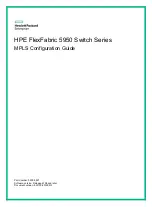
2
320B
A label switched path (LSP) is the path along which packets of an FEC travel through an MPLS
network.
An LSP is a unidirectional packet forwarding path. Two neighboring LSRs are called the upstream
LSR and downstream LSR along the direction of an LSP. As shown in
657H
Figure 2
, LSR B is the
downstream LSR of LSR A, and LSR A is the upstream LSR of LSR B.
Figure 2 Label switched path
321B
LFIB
The Label Forwarding Information Base (LFIB) on an MPLS network functions like the Forwarding
Information Base (FIB) on an IP network. When an LSR receives a labeled packet, it searches the
LFIB to obtain information for forwarding the packet. The information includes the label operation
type, the outgoing label value, and the next hop.
322B
Control plane and forwarding plane
An MPLS node consists of a control plane and a forwarding plane.
•
Control
plane
—Assigns labels, distributes FEC-label mappings to neighbor LSRs, creates the
LFIB, and establishes and removes LSPs.
•
Forwarding
plane
—Forwards packets according to the LFIB.
137B
MPLS network architecture
An MPLS network has the following types of LSRs:
•
Ingress
LSR
—Ingress LSR of packets. It labels packets entering into the MPLS network.
•
Transit
LSR
—Intermediate LSRs in the MPLS network. The transit LSRs on an LSP forward
packets to the egress LSR according to labels.
•
Egress
LSR
—Egress LSR of packets. It removes labels from packets and forwards the
packets to their destination networks.











































